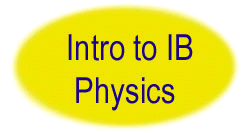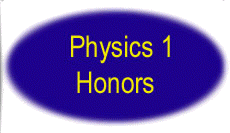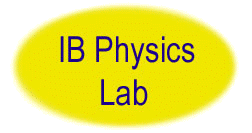











Introduction to IB Physics
The International Baccalaureate Diploma Program is a rigorous pre-university course of studies, leading to examinations that meet the needs of highly motivated secondary school students between the ages of 16 and 19 years. Designed as a comprehensive two-year curriculum that allows its graduates to fulfill requirements of various national education systems, the Diploma Program model is based on the pattern of no single country but incorporates the best elements of many. The Program is available in English, French and Spanish.
The curriculum has six academic areas surrounding the core. Subjects are studied concurrently and students are exposed to the two great traditions of learning: the humanities and the sciences.
Diploma Program candidates are required to select one subject from each of the six subject groups. At least three and not more than four are taken at higher level (HL), the others at standard level (SL). Higher-level courses represent 240 teaching hours; standard level courses cover 150 hours. By arranging work in this fashion, students are able to explore some subjects in depth and some more broadly over the two-year period; this is a deliberate compromise between the early specialization preferred in some national systems and the breadth found in others.
Distribution requirements ensure that the science-orientated student is challenged to learn a foreign language and that the natural linguist becomes familiar with science laboratory procedures. While overall balance is maintained, flexibility in choosing higher-level combinations allows the student to pursue areas of personal interest and to meet special requirements for university entrance.
Successful Diploma Program candidates meet three requirements in addition to the six subjects. The interdisciplinary Theory of Knowledge (TOK) course is designed to develop a coherent approach to learning, which transcends and unifies the academic areas and encourages appreciation of other cultural perspectives. The extended essay of some 4000 words offers the opportunity to investigate a topic of special interest and acquaints students with the independent research and writing skills expected at university. Participation in the creativity, action, and service (CAS) requirement encourages students to be involved in artistic pursuits, sports and community service work.
The Nature of Physics
Physics is the most fundamental of the experimental sciences as it seeks to explain the universe itself, from the very smallest particles -- quarks (perhaps 10-17 m in size) which may be truly fundamental to the vast distances between galaxies (1024 m).
Classical physics, built upon the great pillars of Newtonian mechanics, electromagnetism and thermodynamics, went a long way in deepening our understanding of the universe. From Newtonian mechanics came the idea of predictability in which the universe is deterministic and knowable. This led to Laplace's boast that by knowing the initial conditions, the position and velocity of every particle in the universe he could, in principle, predict the future with absolute certainty. Maxwell's theory of electromagnetism described the behavior of electric charge and unified light and electricity, while thermodynamics described the relation between heat and work and described how all-natural processes increase disorder in the universe.
However, experimental discoveries dating from the end of the nineteenth century eventually led to the demise of the classical picture of the universe as being knowable and predictable. Newtonian mechanics failed when applied to the atom and has been superseded by quantum mechanics and general relativity. Maxwell's theory could not explain the interaction of radiation with matter and was replaced by quantum electrodynamics (QED). More recently, developments in chaos theory, in which it is now realized that small changes in the initial conditions of a system can lead to completely unpredictable outcomes, have led to a fundamental rethinking in thermodynamics.
While chaos theory shows that Laplace's boast is hollow, quantum mechanics and QED show that the initial conditions Laplace required are impossible to establish. Nothing is certain and everything is decided by probability. But there is still much that is unknown and their will undoubtedly be further paradigm shifts as our understanding deepens.
Despite the exciting and extraordinary development of ideas throughout the history of physics, certain things have remained unchanged. Observations remain essential at the very core of physics, and this sometimes requires a leap of imagination to decide what to look for. Models are developed to try to understand the observations and these themselves can become theories, which attempt to explain the observations. Theories are not directly derived from the observations but need to be created. These acts of creation can sometimes compare to those in great art, literature and music, but differ in one aspect which is unique to science: the predictions of these theories or ideas must be tested by careful experimentation. Without these tests a theory is useless. A general or concise statement about how nature behaves, if found to be experimentally valid over a wide range of observed phenomena, is called a law or a principle.
The scientific processes carried out by the most eminent scientists in the past are the same ones followed by working physicists today and, crucially, are also accessible to all students. Early in the development of science physicists were both theoreticians and experimenters (natural philosophers). The body of scientific knowledge has grown in size and complexity and the tools and skills of theoretical and experimental physicists have become so specialized that it is difficult (if not impossible) to be highly proficient in both areas. While students should be aware of this, they should also know that the free and rapid interplay of theoretical ideas and experimental results in the public scientific literature maintains the crucial links between these fields.
All students should undertake both theory and experiments. They should complement one another naturally, as they do in the wider scientific community. The Diploma Program physics course allows students to develop traditional practical skills and techniques and increase facility in the use of mathematics, which is the language of physics. It also allows students to develop interpersonal skills, and information and communication technology skills which are essential in modern scientific endeavor and are important life-enhancing, transferable skills in their own right.
Alongside the growth in our understanding of the natural world, perhaps the more obvious and relevant result of physics to most of our students is our ability to change the world. This is the technological side of physics in which physical principles have been applied to construct and alter the material world to suit our needs, and have had a profound influence on the daily lives of all human beings; for good or bad. This raises the issue of the impact of physics on society, the moral and ethical dilemmas and the social, economic and environmental implications of the work of physicists. These concerns have become more prominent as our power over the environment has grown, particularly amongst young people for whom the importance of the responsibility of physicists for their own actions is self-evident.
Physics is therefore, above all, a human activity and students need to be aware of the context in which physicists work. Illuminating its historical development places the knowledge and the process of physics in a context of dynamic change in contrast to the static context in which physics has sometimes been presented. This can give students insights into the human side of physics: the individuals; their personalities, times and social milieux; and their challenges, disappointments and triumphs.
AIMS
Through studying any of the group 4 subjects, students should become aware of how scientists work and communicate with each other. It will generally involve the formation, testing and modification of hypotheses through observation and measurement, under the controlled conditions of an experiment. It is this approach, along with the falsifiability of scientific hypotheses, that distinguishes the experimental sciences from other disciplines and characterizes each of the subjects within group 4.
It is in this context that all the Diploma Program experimental science courses should aim to:
1. provide opportunities for scientific study and creativity within a global context which will stimulate and challenge students
2. provide a body of knowledge, methods and techniques which characterize science and technology
3. enable students to apply and use a body of knowledge, methods and techniques which characterize science and technology
4. develop an ability to analyze, evaluate and synthesize scientific information
5. engender an awareness of the need for, and the value of, effective collaboration and communication during scientific activities
6. develop experimental and investigate scientific skills
7. develop and apply the students' information technology skills in the study of science
8. raise awareness of the moral, ethical, social, economic and environmental implications of using science and technology
Course Title: Physics II (SL & HL)- International Baccalaureate
Credit: 1.0
Physics II will meet graduation requirements for Science, AP Physics (B), and IB Physics core. The difference between physics B and C is as follows.
AP Physics B is a survey course that is non-calculus based. The course covers classical (pre-20th century) and modern physics (20th century to present). The mathematic requirements are algebra and trigonometry. It is equivalent to PHYS 3053 and 3054. These two-college courses are required for pre-med, life science, and liberal art students. If taken in high school, the student will receive more physics contact hour than in college. As college physics doesn't require high school physics, AP physics B doesn't require a high school physics prerequisite. However, algebra and trigonometry are prerequisites.
AP Physics C is equivalent to the first two semesters of college engineering physics. It covers mechanics (18th century physics) and electricity and magnetism (19th century physics). This is a calculus-based course. Unlike physics B, physics C offers the nice option for a student to earn two separate scores one for mechanics and the other electricity and magnetism. Again, there is no high school physics as a prerequisite. However, calculus is a co-requisite.
A. Major concepts/content. The purpose of this course is to provide a college-level course in
physics and to prepare students to seek credit and/or appropriate placement in college physics courses. The content should include, but not be limited to, the following:
- mechanics
- vibration & wave motion
- electricity and magnetism
- atomic and quantum physics
- AP Physics B includes Optics
B. Special note. Laboratory work involves application of the scientific method, quantitative relationships, proper use of laboratory apparatus, and safety precautions.
C. Textbook. Serway, R.A. and Faughn, J.S. College Physics. Third Edition. FYI…The authors have published the 6th edition.
D. Chapters. The IB program has specific content areas to cover this year. Those chapters in Serway & Faughn are: 1 to 17.4; 18 to 19.3; 20 to 22.1; 29 to 30; and 32 to 33.